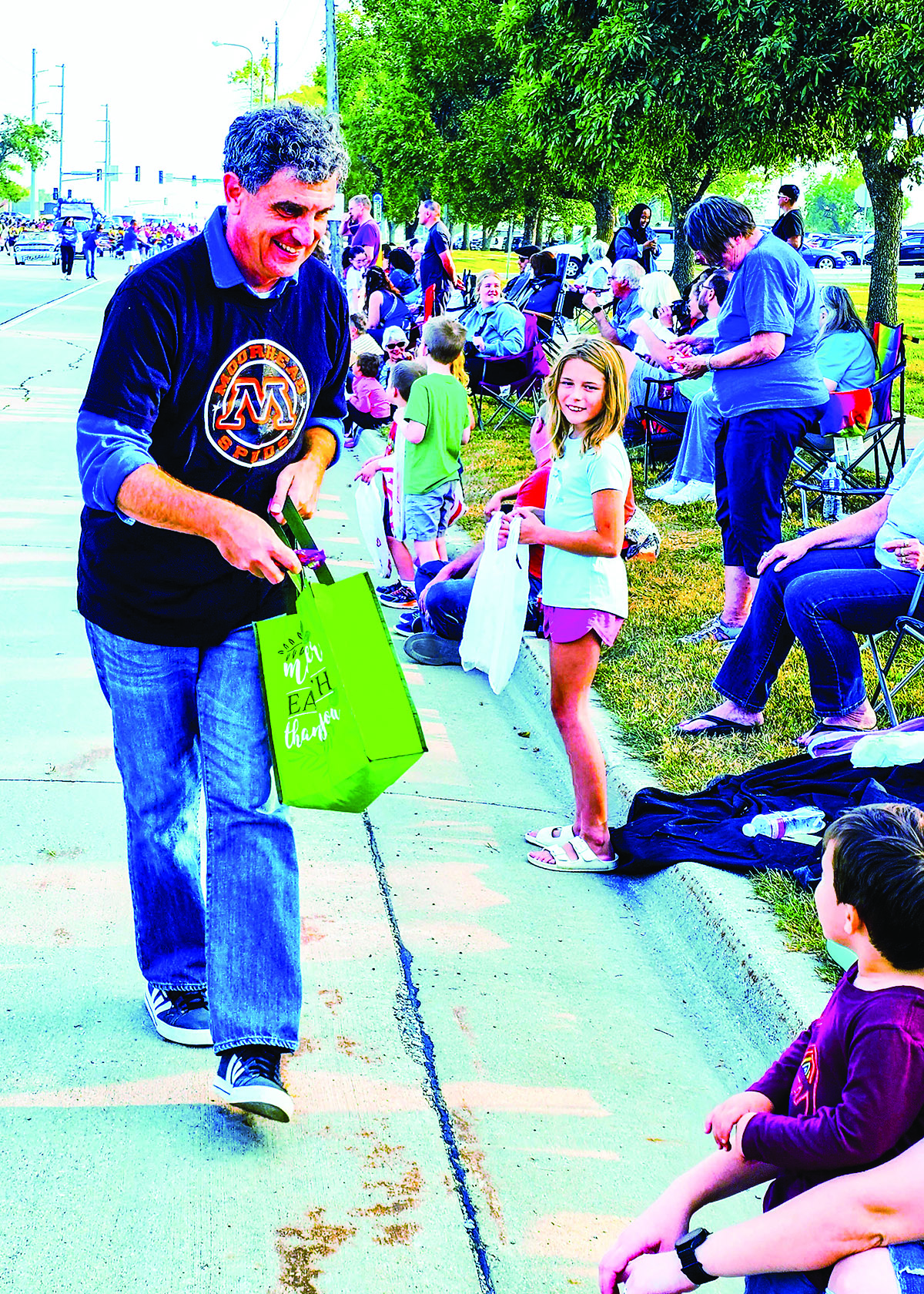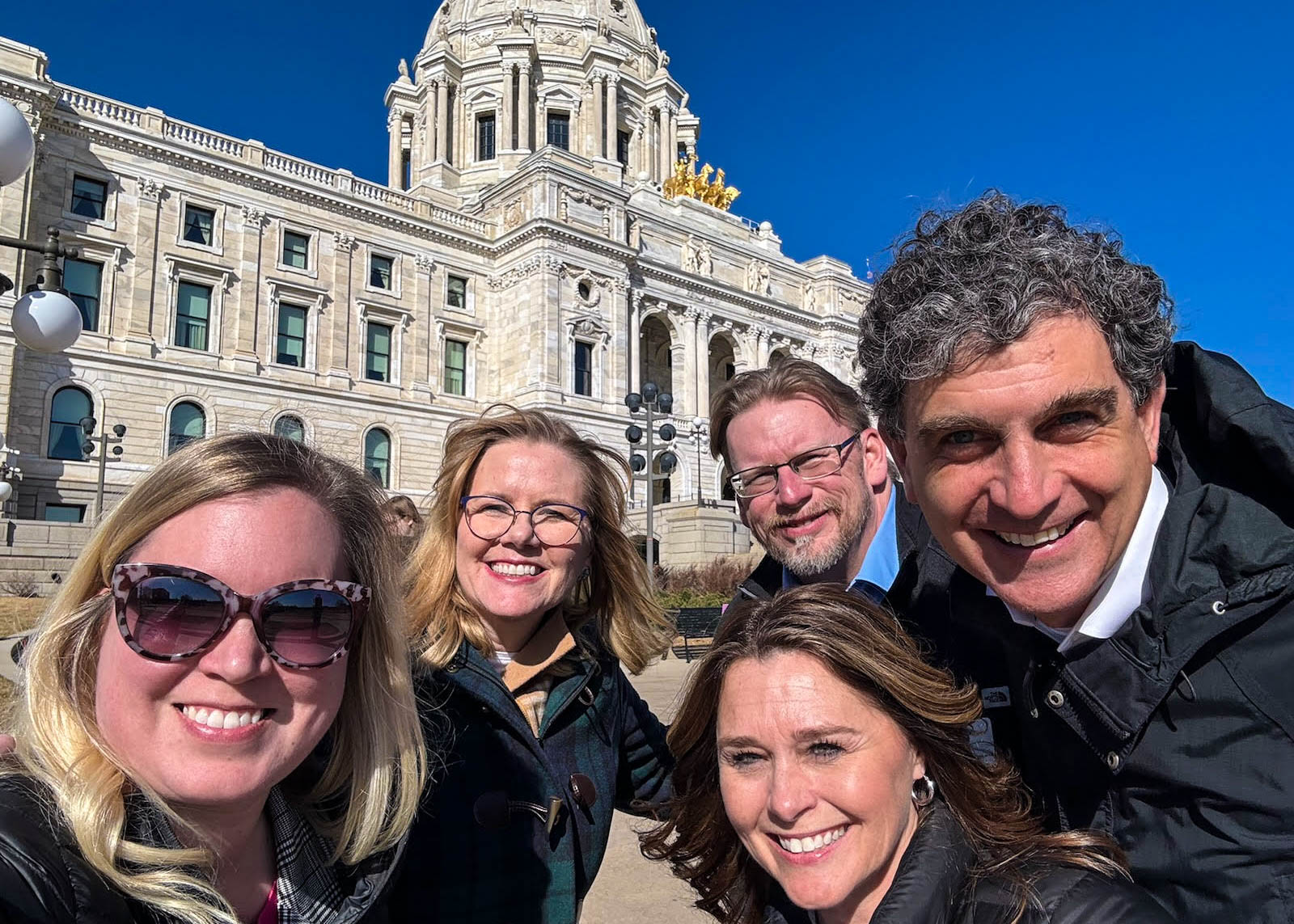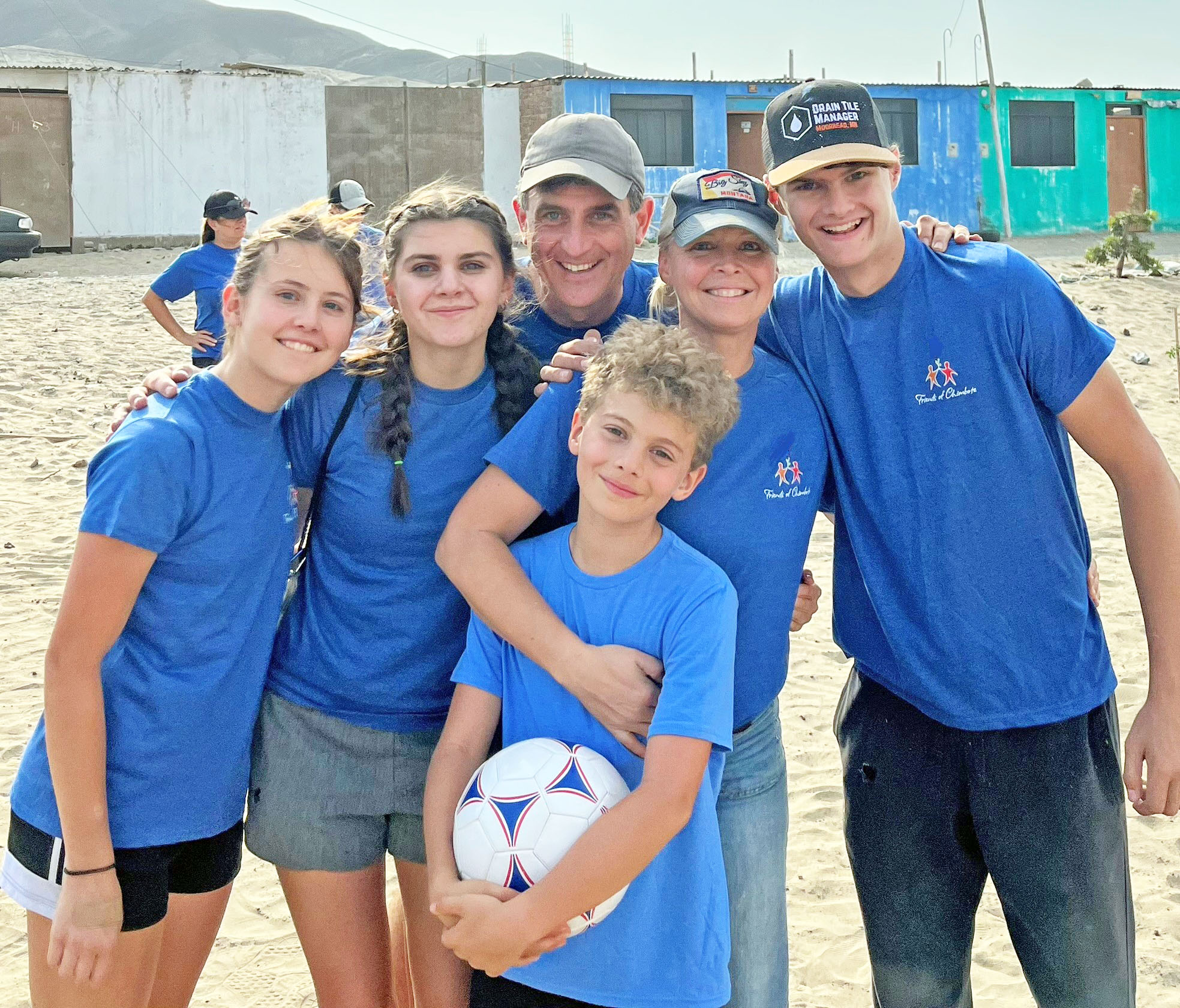
City manager Dan Mahli gently tosses candy to children watching the Greater Moorhead Days parade in September.

City manager Dan Mahli and a delegation of Moorheaders lobbied the Minnesota Legislature for the city’s priorities. From left: Council member Laura Caroon, director of governmental affairs Lisa Bode, council member Chuck Henderson, Mayor Shelly Carlson, and Mahli. (Photos courtesy Dan Mahli.)

Dan and Kim Mahli and their four children regularly go on mission trips to help poverty-stricken residents in Peru.

City manager Dan Mahli says he was “somewhere in the middle to last” of thew BRRR Bicycle Race on the trails along the Red River. It’s held in the middle of winter and, he says, “can make a person hallucinate.”
Nancy Edmonds Hanson
When Dan Mahli was growing up, his mother would tell him and his brother, “When you want to go fast, go alone. If you want to go far, go together.”
He has never forgotten. That principle – making progress as a team – has stayed at the forefront ever since. From working as a warming house attendant and at Happy Joe’s as a teen and assistant curator (“basically a custodian”) at the Hjemkomst museum to his career municipal government, his belief in his mother’s wisdom has never flagged.
That’s what Dan has brought to Moorhead since being named assistant city manager in 2017 and rising to lead the community’s 290 public employees in 2020.
It has been a rather momentous time in the city’s 150-year history. Its residents – more than 45,000 – have watched as the 56-year-old Moorhead High School was reduced to rubble, then arose again in streamlined contemporary form. They have seen the 50-year-old Center Mall, long into its dotage, demolished to make way for a reimagined, reinvigorated vision of downtown. They can now dodge ever-present trains on the 20/21st/Main triple underpass near the high school and are watching the priciest infrastructure project in the city’s history dig in along 11th Street. There’s even that promising recent hint of a $5 billion sustainable aviation fuel plant in coming years, the latest in a solid record of economic developing.
Things, in other words, are looking up. Dan attributes much of that progress to the people of Moorhead … yes, working together. “People are good and smart here,” he says, repeating a statement he’s been making for the last five years: “Moorhead has good bones.”
Since stepping into the shoes of former manager Christina Volkers, Dan has worked hard to put his belief in people into action. Rather than top-down decision-making, he has concentrated on being accountable, staying consistent with local plans, and encouraging the voices of residents to be heard.
One major job completed during Dan’s tenures was “Onward Moorhead,” the comprehensive plan intended to guide the city’s development over the coming decade. Hundreds of residents contributed to the planning process, which wrapped up in 2022, from technical advisors in city departments to a broadly representative study review committee ranging from representatives of religious, ethnic and other community groups to leaders in business and education.
The document that emerged includes five so-called “big ideas.” One big idea is the transformation of downtown into the heart of the community, with a range of housing and retail options, cultural amenities, parks and public services. Others include redevelopment of residential and retail centers throughout the city; connecting neighborhoods to parks and trails along the river; plans to adapt to climate change, from flooding to other environmental and economic challenges; and building and nurturing local businesses, focusing on what makes Moorhead “unique and authentic.”
“Moorhead is working to tell its story better,” the city manager observes. Near the top of the amenities to which he points with pride is the river that courses at the city’s west edge.
He is excited about the possibilities of a reinvigorated downtown. “This is not a historic preservation project. Urban renewal eliminated that possibility in the 1960s and ‘70s. Instead, we’re seeing the beginning of something new – a walkable neighborhood center of residences and businesses and services.” What’s happening is the result of bringing the community together, listening to residents’ ideas and wishes, taking stock, and including them as plans were laid.
The first concrete evidence of that collaboration, of course, can be seen today. The new community center and library is rising on one corner of the demolished mall’s parking lot. The first commercial development is coming on its eastern edge, where the 650 Block’s two buildings are taking shape, combining residential living with commercial space. Fourth, Fifth and Sixth streets are about to reemerge across the 20-acre shopping center plot, recalling the way the city’s byways used to be. Even City Hall – five stories being gutted and redesigned, with a public plaza planned on the river.
“We had a goal of building 500 living units downtown in five years,” Dan notes. “We surpassed that earlier this year. That five-square-block area is becoming a real neighborhood, with everything people need – a supermarket, a hardware store, offices, health clinics, a sporting good store event venues,a library, two museums, a community theatre, parks, river trails, coffee shops, restaurants, breweries, you name it – all within a five-minute walk.”
When Dan, a 1991 graduate of Fargo South High School, was studying at North Dakota State University, he and a friend were having the kind of deep, meandering late-night conversation to which college students are prone. It was the turbulent time of the Los Angeles riots of 1992. Reflecting on the troubles, he pondered, “Wouldn’t it be great to live in a place where folks feel like they belong and the parks are great?”
His buddy responded, “Wow! We should start our own city.”
Not long afterward, he was working the cash bar at a reception at the Hjemkomst when Mayor Morrie Lanning and city manager Jim Antonen asked the question that every undecided college senior hears: What are you going to do after you graduate? “I told them I’d planned to go to law school, but I couldn’t figure out how to answer,” Dan remembers. “I added, half joking, that I wanted to start a new city. Out of the blue, Jim mentioned a friend in Moorhead IT department had recommended me as a prospective intern in the city manager’s office.”
He came on board. Dan ditched law school and enrolled in Moorhead State University’s graduate program in public and human service administration. Afterward, he worked for U.S. Sen. Byron Dorgan for a time, following up on acquaintances begun years before when he served as his intern in Washington, D.C. (“I was in the same intern cohort as Monica Lewinsky,” he confides.)
After spending his first post-graduate year as the director of the Park Rapids Area Chamber of Commerce, Dan returned home to work as one of Fargo’s city planners. He held that position for 18 years. But he was ready for a change in 2017. It came about when Moorhead’s city manager, Mike Red linger, was hired across the river as Fargo’s assistant city manager. Dan would ultimately make the same move, but in the opposite direction. He became Moorhead’s assistant manager under the woman who replaced Redlinger, Chris Volkers. When she resigned in 2020 for a job in a Twin Cities suburb, Dan was ultimately chosen to succeed her. (Redlinger moved up to the same position on the west side of the river in 2022.)
Dan inherited his deep faith in people and his interest in public service from his parents, Maurice and Ellen Mahli. Both worked in health care. When his father became an administrator at St. John’s Hospital in Fargo, his wife and two boys moved from Minneapolis. Maurice died in 2015. Now retired after 58 years as a clinical nurse, Ellen continues the couple’s lifelong commitment to peace, justice and community service, locally and around the world.
Now Dan’s family carries on that tradition. Along with wife Kim and their four children, he recently returned from one of their regular mission trips to Peru. “We work with the children and grandchildren of the survivors my mom and dad worked with in Chimbote after the Great Peruvian Earthquake of 1970,” he says. “That natural disaster killed 70,000 people and left 800,000 Peruvians homeless. Today, friends and volunteers still work to empower community leaders and people living in extreme poverty with clean water, education, economic well-being and safe housing.”
That experience reinforces Dan’s fervent belief that the great good thing in every community is its people. “True greatness isn’t in money or numbers. It’s in all of us pulling together and moving forward in one direction as a team,” he emphasizes.
“I believe leaders can be calm and compassionate. They can be kind. They can be curious and courageous, and still be extremely effective … united with vision and purpose. I think we have that here. Our city’s employees have positive working relationships in the community, mutual respect with the city council … and we hold each other’s trust.”


